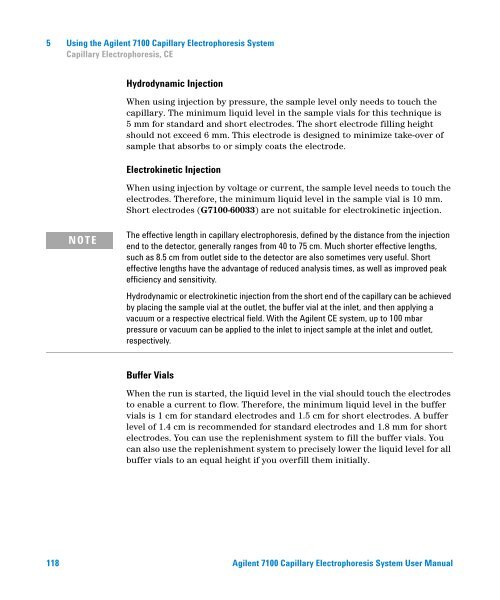Introduction to the Agilent 7100 Capillary Electrophoresis System
Introduction to the Agilent 7100 Capillary Electrophoresis System
Introduction to the Agilent 7100 Capillary Electrophoresis System
Create successful ePaper yourself
Turn your PDF publications into a flip-book with our unique Google optimized e-Paper software.
5 Using <strong>the</strong> <strong>Agilent</strong> <strong>7100</strong> <strong>Capillary</strong> <strong>Electrophoresis</strong> <strong>System</strong><br />
<strong>Capillary</strong> <strong>Electrophoresis</strong>, CE<br />
Hydrodynamic Injection<br />
When using injection by pressure, <strong>the</strong> sample level only needs <strong>to</strong> <strong>to</strong>uch <strong>the</strong><br />
capillary. The minimum liquid level in <strong>the</strong> sample vials for this technique is<br />
5 mm for standard and short electrodes. The short electrode filling height<br />
should not exceed 6 mm. This electrode is designed <strong>to</strong> minimize take-over of<br />
sample that absorbs <strong>to</strong> or simply coats <strong>the</strong> electrode.<br />
Electrokinetic Injection<br />
When using injection by voltage or current, <strong>the</strong> sample level needs <strong>to</strong> <strong>to</strong>uch <strong>the</strong><br />
electrodes. Therefore, <strong>the</strong> minimum liquid level in <strong>the</strong> sample vial is 10 mm.<br />
Short electrodes (G<strong>7100</strong>-60033) are not suitable for electrokinetic injection.<br />
NOTE<br />
The effective length in capillary electrophoresis, defined by <strong>the</strong> distance from <strong>the</strong> injection<br />
end <strong>to</strong> <strong>the</strong> detec<strong>to</strong>r, generally ranges from 40 <strong>to</strong> 75 cm. Much shorter effective lengths,<br />
such as 8.5 cm from outlet side <strong>to</strong> <strong>the</strong> detec<strong>to</strong>r are also sometimes very useful. Short<br />
effective lengths have <strong>the</strong> advantage of reduced analysis times, as well as improved peak<br />
efficiency and sensitivity.<br />
Hydrodynamic or electrokinetic injection from <strong>the</strong> short end of <strong>the</strong> capillary can be achieved<br />
by placing <strong>the</strong> sample vial at <strong>the</strong> outlet, <strong>the</strong> buffer vial at <strong>the</strong> inlet, and <strong>the</strong>n applying a<br />
vacuum or a respective electrical field. With <strong>the</strong> <strong>Agilent</strong> CE system, up <strong>to</strong> 100 mbar<br />
pressure or vacuum can be applied <strong>to</strong> <strong>the</strong> inlet <strong>to</strong> inject sample at <strong>the</strong> inlet and outlet,<br />
respectively.<br />
Buffer Vials<br />
When <strong>the</strong> run is started, <strong>the</strong> liquid level in <strong>the</strong> vial should <strong>to</strong>uch <strong>the</strong> electrodes<br />
<strong>to</strong> enable a current <strong>to</strong> flow. Therefore, <strong>the</strong> minimum liquid level in <strong>the</strong> buffer<br />
vials is 1 cm for standard electrodes and 1.5 cm for short electrodes. A buffer<br />
level of 1.4 cm is recommended for standard electrodes and 1.8 mm for short<br />
electrodes. You can use <strong>the</strong> replenishment system <strong>to</strong> fill <strong>the</strong> buffer vials. You<br />
can also use <strong>the</strong> replenishment system <strong>to</strong> precisely lower <strong>the</strong> liquid level for all<br />
buffer vials <strong>to</strong> an equal height if you overfill <strong>the</strong>m initially.<br />
118 <strong>Agilent</strong> <strong>7100</strong> <strong>Capillary</strong> <strong>Electrophoresis</strong> <strong>System</strong> User Manual
















